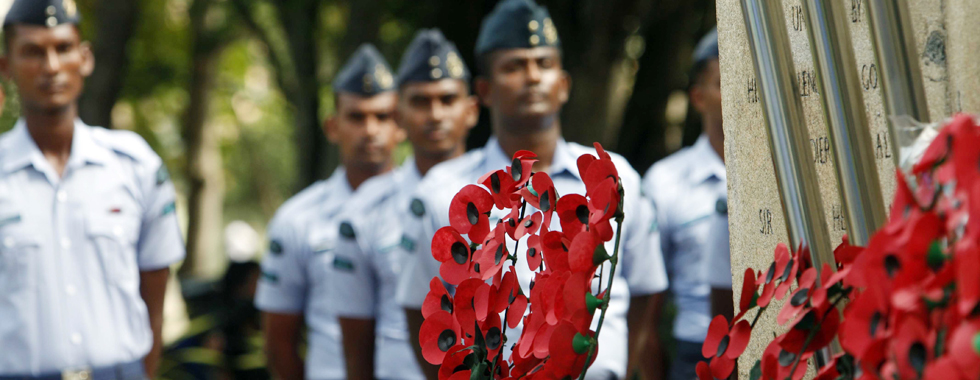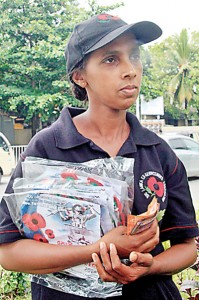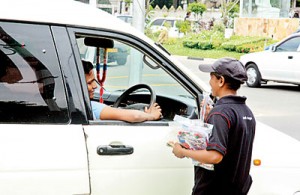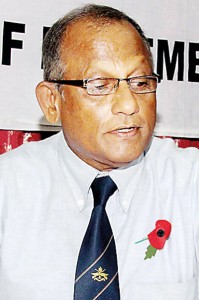Paper poppies that go a long way
Have you bought your poppy? Sri Lanka and the world will mark Remembrance Day on November 11 (Tuesday) and city dwellers may have been accosted by the poppy sellers, urging them to buy a single blossom, a poppy wreath, flag or sticker for their vehicles . Sri Lanka has followed this tradition since colonial years but over time it has evolved into something more meaningful for many as the country’s own turbulent conflict also left its mark.

Remembering our fallen heroes: Last Year’s Remembrance Day event near the Cenotaph War Memorial
However one chooses to wear it the poppy is deeply symbolic. We traced the poppy to learn more about its significance.
Out story begins with the poppy sellers themselves. Hard pressed to find these sellers on a rainy weekday we finally bump into some at the Borella kanaththa junction. Two ladies, caps pulled low over their heads against the drizzle, are working the traffic during the midday rush. They are more often than not ignored, and occasionally harassed too, but they are also persistent. “We’re volunteers,” explains Gayani Wajiramanne. “We all have brothers, sisters or parents who served in the Army.” Gayani has been doing this for five years, and receives nothing in return except the satisfaction of having made her contribution.

Gayani: “We all have brothers, sisters or parents who served in the Army”
“Sometimes I sell about 30 to 40 wreaths a day,” shares S.D. Niluka. “Some days it’s barely 10.” Niluka is not occupied professionally and happily gives her time to the cause. Her brother served in the Army and these flowers are deeply symbolic for her family. Every day Niluka and her fellow volunteers assemble at city junctions and public spaces to encourage people to not just buy a poppy, but also to wear one. “It’s not easy work,” she says. “But we don’t mind.”
The paper poppies they sell are distributed solely by the Sri Lanka Ex-Servicemen’s Association, which

Niluka: “It’s not easy work”. Pix by Indika Handuwala
received one million poppies this year through the Royal Commonwealth Ex-Services League from the Royal British Legion in England. Since its establishment in 1944, the Sri Lanka Ex-Servicemen’s Association has been responsible for the procurement and distribution of the poppies, which are only made in England by disabled soldiers and their families. “We get these poppies at almost no cost,” explains the association’s president, Brigadier K.A. Gnanaweera.
The Ex-Servicemen’s Association works with 43 affiliate organisations associated with the armed forces to distribute these poppies around the country. The affiliate organisations rally volunteers from around the country to encourage the public to purchase the poppies. As such, these poppies can only be bought from these volunteers, an affiliate or the Ex-Servicemen’s Association headquarters on Bristol Street, Fort.
The funds collected from the poppies are directed towards the welfare activities of the Ex-Servicemen’s Association and its affiliate organisations.

Major General A.K. Sooriyabandara
A common misconception is that a certain percentage of these funds is channelled back to England, explains Major General A.K. Sooriyabandara, the Armed Forces Remembrance Day and Poppy Committee Chairman. “All the proceeds are directed towards running our home for veterans in Katana and to our affiliates for their welfare activities,” he says.
The home serves veterans of World War II and Sri Lanka armed forces personnel as well, and is run at a cost of Rs. 5 million annually. In addition, monthly grants for 530 veterans and their families totalling Rs. 6.7 million, medical grants amounting to Rs. 3.5 million and scholarships for university students at Rs. 700,000 are also provided by the organisation, according to figures provided by Secretary General Rear Admiral S.R. Samaratunga.
“So you see, the poppy goes a long way in helping us to serve those who served this country,” says immediate Past President Captain Patrick Jayasinghe. Last year poppy sales raised Rs. 18 million and this year the association hopes to raise Rs. 25 million from sales that will comprise the single poppy, wreaths, stickers and donation tills placed at supermarkets and other venues. Don’t just purchase the poppy, appeal these ex-servicemen, but wear it as a badge of honour too. “When we see people wearing the poppies there’s a sense of brotherhood,” they say. “We feel like the public is with us, even if we have retired or are unable to serve anymore.”
| Today’s the day at the War Memorial
This year, the Armed Forces Remembrance Day celebrations will take place today at the Viharamahadevi Park, as always near the Cenotaph War Memorial, a commemorative structure built in the 1920’s at Galle Face Green to commemorate the lives of men and women who died during World War I. It was later dismantled and brought to Viharamahadevi Park (then Victoria Park) during World War II for security reasons. While it may be seen in a different context in post-colonial Sri Lanka, the structure is an important reminder of the value and sanctity of peace, say the organisers. The Armed Forces Remembrance Day celebrations will begin at 9 a.m, and members of the public are welcome to attend.
Recalling Flanders Fields The red field or corn poppy (scientific name papaver rhoeas) grew naturally in disturbed earth in and around Western Europe. The poppy came to be a potent symbol of war when the destruction of the Napoleonic Wars of the early 19th century transformed bare land into fields of blood red poppies, growing around the bodies of fallen soldiers. This came to be once more in 1914, when the First World War bloodied the fields of Northern France and Flanders, and the poppies were the only flowers to bloom on the barren battlefields. It was Major John McCrae who captured the flower’s symbolism with his poem, ‘In Flanders Fields’, writing “… If ye break faith with us who die, we shall not sleep, though poppies grow in Flanders field” at the second Battle of Ypres in 1915. The poppy soon came to symbolise the courage and immeasurable sacrifice of the soldiers who served and died during that war. On November 11, 1918 ceasefire was declared and the day was adopted as the ‘Day of Remembrance’. Today poppies made in the UK are sent to 120 countries around the world. |


